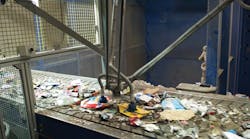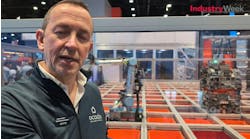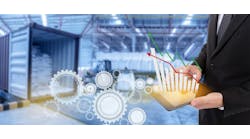Merriam-Webster’s dictionary defines artificial intelligence (AI) as the capability of a machine to imitate intelligent human behavior. While the first references to AI date back to more than 60 years ago, the past few decades of technology advancements have brought a new fervor to the industry. While sectors like manufacturing and transportation have been utilizing AI for years, applications of the technology is expanding to new businesses and industries. While the recycling industry might not be what your mind immediately jumps to, AI is actually a perfect fit.
Once recyclables have been used and are collected—most commonly via a residential curbside recycling program—they are taken to a materials recovery facility (MRF). Each day tons of recyclable materials are sorted and baled at MRFs before being sent on to other facilities, where they are turned into a wide and growing list of new products made with recycled content. Let’s focus on the sorting, which is a crucial piece to the recycling logistics puzzle.
Thanks to a partnership between the Carton Council of North America and AMP Robotics, a new player has entered the sorting game for food and beverage cartons. Clarke is a robot that grabs and sorts food and beverage cartons from a conveyor belt as recyclables are separated. Clarke is currently installed at Alpine Waste & Recycling MRF in Denver, Colo.
Why cartons? The Carton Council is a coalition of five carton manufacturers that have worked together since 2009 to grow and improve carton recycling across the United States. Cartons are a food and beverage packaging option that are made primarily of paper and represent some of the highest-quality virgin fiber in the residential recycling stream. You can find a wide variety of products in cartons, such as milk, juice, broth, soup, beans, water and wine.
Back in 2009, carton recycling access stood at just 18%, meaning that most Americans had no way to recycle their cartons despite the fact that they contain valuable material. Since its inception, the Carton Council has collaborated with organizations, companies and governments across the recycling value chain to foster new end market options for cartons and provide support for companies to develop new technologies to more efficiently and effectively sort cartons.
AMP, which stands for Autonomous Manipulation and Perception, creates scalable robotic systems designed to reduce the cost of recycling while enabling “smart” recycling facilities by providing information on the efficiency of equipment and flow of materials.
The Fine Print
Officially called the AMP Cortex system, the robot is nicknamed Clarke, named after science fiction author and futurist Sir Arthur C. Clarke. Cortex uses a camera, much like the one on a typical smartphone, to scan materials as they pass through a conveyor belt on the recycling line. It uses AI that learns from experience to be able to identify the thousands of food and beverage cartons from the other materials on the line.
Cortex is also able to identify the different kinds of carton packaging, from knowing the difference between gable-top and aseptic cartons to being able to differentiate a broth or almond milk carton to knowing a package is not a carton and should therefore not be sorted with them. In fact, Cortex has learned to identify more than 150 carton variations and is constantly learning more.
Once Cortex identifies that a carton is nearby, it uses spider-like arms with specially designed grippers (similar to suction cups) to pick up and separate the cartons. While it identifies materials much like the human eye would, it can do so much faster and more efficiently. Cortex is currently performing at 60 picks per minute, or one carton per second, and is performing around 90% accuracy. For comparison, the average human has a pick rate of 40 cartons per minute. The Clarke unit is currently working 16 hours a day, and has been operating for over one man-year. As Cortex is constantly learning, the performance will also continue to increase.
Cortex can monitor the material stream, tracking recyclables as they move from pre-sort line, through the facility, to the residual line. The system maintains full awareness of the material that passes through it, and can be used to gather data including recoverable materials.
Expanding the Sort
Perhaps the best part is that as new systems are installed at other MRFs, the robots will have a small learning curve, as the insights Cortex has learned will be passed on. The robots will learn from each other as they go and will be able to share these insights across all the systems.
In fact, Dem-Con Companies, a full-service recycling, processing and disposal company, has recently added a robot to its facility in Shakopee, Minn. Dem-Con puts a lot of value in innovation and new technologies, as well as environmental stewardship and resident education, making them a good fit for the next installation of the robot. Their resident education program includes hosting three to five “Green Grades” tours a month for students to get a taste of recycling and responsible waste processing.
Starting this fall, these tours will also showcase a recycling robot in action. This robot will have a jump start on its ability to separate food and beverage cartons, as it will have access to all the knowledge Clarke has already learned in Colorado.
As this second robot will perform under different conditions (e.g., size of the line, lighting, conveyor figurations), it provides the opportunity to not only apply the learnings from the Alpine facility, but to also gain new knowledge and insights that can be applied to future robots and locations. Clarke in Colorado will learn from the robot in Minnesota just as much as the Minnesota robot learns from Clarke.
Looking to the Future
While AMP Cortex is currently sorting only food and beverage cartons, it is learning from all the materials that pass below it and getting smarter each day. In the future, it will be able to not only sort other recyclables, but also be programmed to pick containments out of the line (such as plastic bags or diapers, for example), leading to a more cost-effective and safer MRF environment for the humans working on the line.
In the not-so-distant future, we envision MRFs to be an environment where robots and humans are regularly working side-by-side to ensure no valuable materials end up in the landfills.
Derric Brown is vice president of sustainability for the Carton Council and director of sustainability for Evergreen Packaging. Matanya Horowitz is the founder of AMP Robotics.



